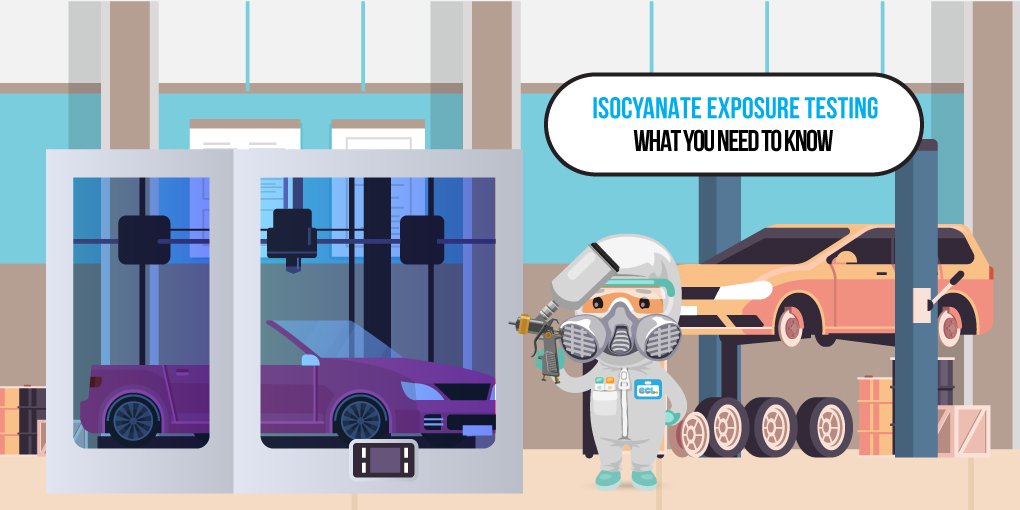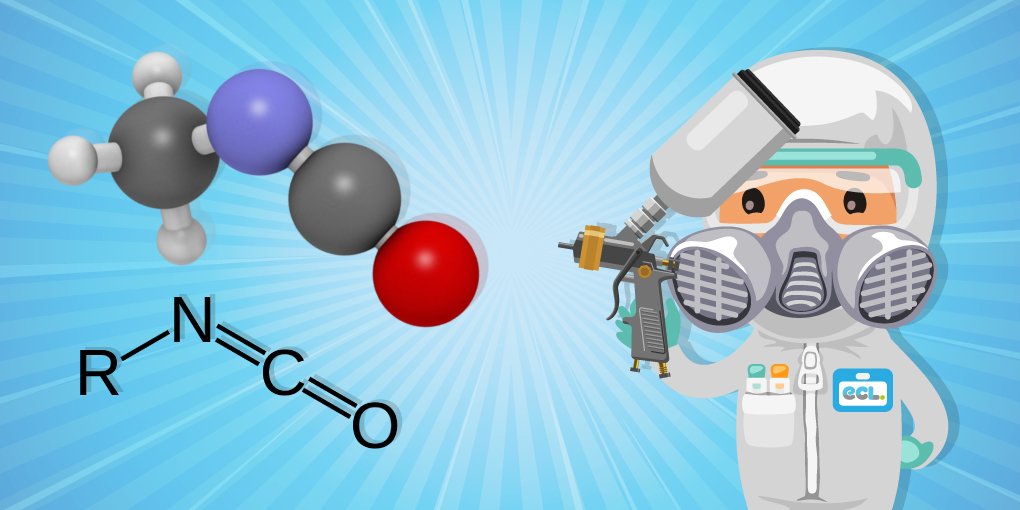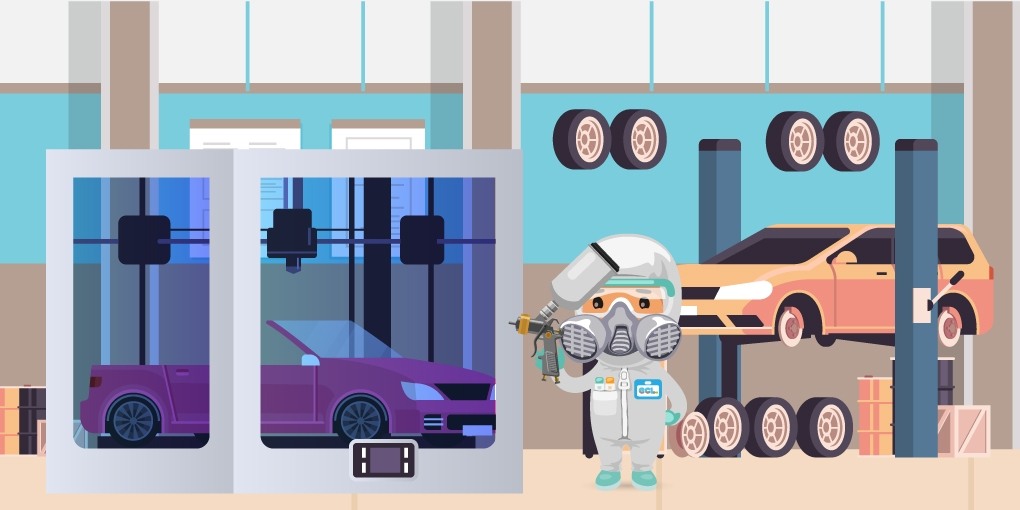Isocyanate Exposure Testing is very important as isocyanates are a collection of chemicals that are widely used in various industries such as the production of polyurethane products, adhesives, and coatings.
Isocyanates can be dangerous and pose a significant health risk to workers who are exposed to them, as they are respiratory sensitisers.
ECL has conducted both Isocyanate Testing in the workplace and Isocyanate Exposure Monitoring from Stacks for over 20 years.
In this article we’ll share our experience and help you understand what isocyanates are, the risks of exposure, who requires testing, the monitoring benefits, Workplace Exposure Limits (WELs), and how we routinely conduct this type of testing.

What Are Isocyanates and Who Requires Testing?
Isocyanates are a group of highly reactive, powerful organic compounds that are used in the production of polyurethane products such as:
- adhesives
- coatings
- elastomers
- floor / roof screeding
- foams
- glues
- hardwearing plastics
- lacquers
- medical dressings
- spray paints
- varnishes
Exposure to isocyanates can occur during all stages of the manufacturing process, from initial surface application to the final cutting or curing of materials.
Isocyanate Testing is required in industries where workers are exposed to isocyanates, such as the Automotive Industry, furniture production, Construction Industry, paint and printing industries.
To control the risk of future health issues in the workplace and comply with UK law and regulations, all employers must ensure isocyanate exposure for employees must to be kept as low as reasonably practicable (ALARP).
Why Test For Isocyanate Exposure?
Isocyanates are extremely dangerous as they can cause a wide range of health problems in workers who are exposed to them.
These irritants can cause skin and respiratory problems in workers who are exposed to them and are considered one of the leading causes of occupational asthma in the UK.
The most common health problem associated with isocyanate exposure is isocyanate poisoning, which presents symptoms to the skin and respiratory problems, including:
- eye irritation
- headaches
- nausea
- itching
- redness
- breathing difficulties.
In the most severe cases, isocyanate exposure can cause more serious long-term health problems such as lung disease and other respiratory illnesses.
With isocyanates being respiratory sensitisers, exposure to them should be kept as low as reasonably practicable. If adequate control measures are in place, these conditions, such as isocyanate poisoning, are easily preventable.
Isocyanate Testing and Biological Monitoring are two rather simple, cost-effective ways of checking that workplace control measures are working effectively, and exposure is being adequately controlled.
The HSE suggests that anyone exposed to contaminants such as isocyanates undertake testing at regular intervals for air/biological monitoring. Typically, this testing has to be carried out by an individual or company who understands the key principles of Occupational Exposure Monitoring and Health Surveillance.
What Are The UK Workplace Exposure Limits For Isocyanates?
The UK exposure limit for isocyanates is currently 0.02 milligrams per cubic metre of air (mg/m3) as an eight-hour time-weighted average (TWA).
The short-term exposure limit (STEL) is 0.07 mg/m3.
These limits are set by the Health and Safety Executive (HSE) under the Control of Substances Hazardous to Health Regulations (COSHH) and are presented in the HSE EH40 document which is regularly checked and, when required, updated.
The current guidance value for biological monitoring is currently 1 µmol/mol creatinine.
How Do You Conduct Isocyanate Testing?
Isocyanate Testing can only be conducted by a qualified professional using a range of specialised equipment.
The testing process for isocyanates involves the collection of air samples, from within the breathing zone of operators in the working environment and analysing them to determine the level of contaminants present.
Based on the results of the isocyanate testing, recommendations will then be made to reduce the exposure of employees and to prevent the potential of future isocyanate exposure.
In addition to health surveillance, it’s recommended that environments where isocyanates are used, undergo regular Occupational Exposure Monitoring to compare levels with the relevant workplace exposure limits. All results should be retained and used to update your company’s COSHH Risk Assessments.
It should be noted that any operator exposure monitoring to determine workplace exposure to airborne isocyanates must be carried out, in accordance with HSE method MDHS 25, by a professional Occupational Hygienist under the restrictions imposed by the UK Home Office. All of ECL’s Occupational Hygiene team are registered members of the British Occupational Hygiene Society (BOHS) faculty and, as such, are authorised to undertake this monitoring under the control of the BOHS Group Authority Licence and are subject to random auditing of their professional practice and competence.

What Is The Hierarchy of Control for Minimizing Isocyanate Exposure?
To fully evaluate employees’ exposure levels and the effectiveness of existing engineering controls, a professional, experienced Occupational Hygiene consultant should always carry out isocyanate exposure monitoring.
The hierarchy of control should always be used to determine the most effective, but most reasonably practicable route to minimise exposure. This can be done by eliminating the use of isocyanates entirely or potentially substituting them with a less hazardous material or alternative process.
If elimination is not possible:
- Investigate Engineering Controls, such as enclosed spray booths
- Provide information, instruction, and training to operators on safe work practices
- Test spray booths annually by a competent person and display clearance time clearly
- Use Personal Protective Equipment (PPE). (All operators handling isocyanates should wear overalls, gloves, and safety glasses.)
A typical isocyanate exposure monitoring program can include:
- Assessment of all potential exposure sources and paths
- Evaluation of employees’ working and exposure patterns
- Evaluation of existing management controls
- Collection of air samples for assessment of inhalation exposure
- Collection of biological samples for assessment of total body exposure/ accumulation
- Use and adequacy of existing control measures
- Recommendation and evaluation of suitable PPE and RPE
Please remember that PPE alone is not sufficient in the use of isocyanates but can be useful when used in conjunction with additional controls.
For Spray Painting: The use of air-fed breathing apparatus must be used and operators should have full training in the use of such respirators. All spraying of material containing isocyanate must also be within a fully enclosed, extracted spray booth.
For Non-spraying Environments: Operators are advised to wear standard respirators with FFP3 and ABEK1 filters. Any operator supplied with close-fitting, filtering facepiece respiratory protective equipment (RPE) should, also be fit-tested for the specific make / model of RPE being used.
How Can ECL Help You?
In conclusion, isocyanates are a serious health risk, but with appropriate controls and precautions, they can be effectively managed to protect workers.
ECL is a leading provider of isocyanate testing services in the UK and can provide both biological monitoring and personal exposure monitoring for isocyanate exposure. Our team can develop and implement monitoring strategies to ensure workplace exposure limits are not exceeded and will advise on the appropriate measures that can be taken to reduce the risk of exposure to ALARP and ensure you comply with the Control of Substances Hazardous to Health Regulations.
Many of our team of professional and qualified Occupational Hygiene consultants have over 20+ years of experience and are equipped with the latest equipment to conduct all types of exposure monitoring, including isocyanates, Wood Dusts and numerous other contaminants.
Our air monitoring services are designed to help businesses, workers and the public stay safe from the dangers of exposure of contaminants in the workplace and external environments.
Our network of local offices across the UK, in Cardiff (Wales), Leeds (West Yorkshire), Newcastle and the West Midlands, allow ECL to provide a cost-effective service nationwide. We currently service a wide range of clients, from small independent UK companies to multi-national corporations in a multitude of industries. From automotive companies, construction firms, to engineering and printing industries.
ECL also offer Local Exhaust Ventilation Thorough Examination and Testing, in accordance with HSE guidance HSG258 and COSHH Regulation 9. All of which are crucial in determining whether your systems are capable of providing satisfactory control of exposure to the hazardous substances as required by UK COSHH regulations.
Fill out our short ECL Enquiry Form or call us on 01443 841760 for any queries regarding COSHH Compliance, Workplace Noise Assessments or any of our other Occupational Hygiene Services.

